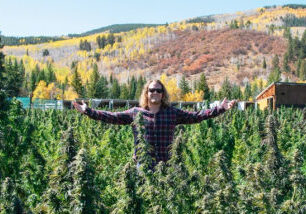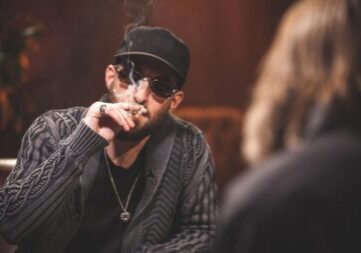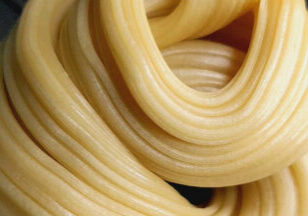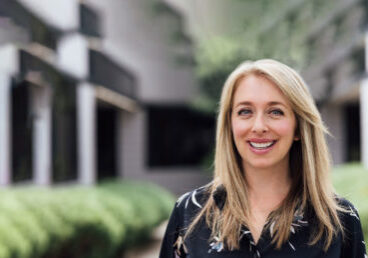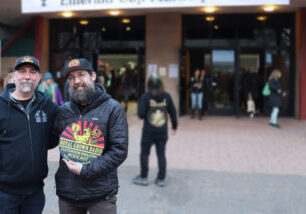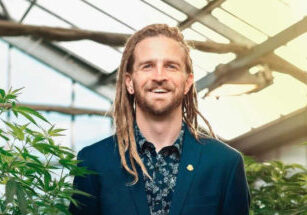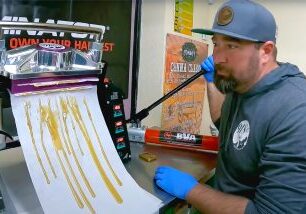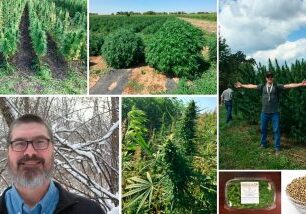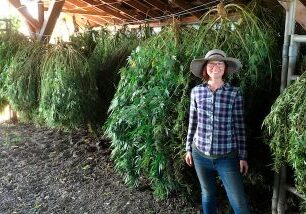Joey Burger, the Humboldt local, and Tamara Thorn, owner of Heal Thyself Gardens, talk with us about starting a cannabusiness, regenerative farming, and cannabis education.
Our hosts for this episode are Reed Preston, founder of Preston Hemp Co, and Dana Mosman, co-founder of Triminator.
Transcript
Reed: Alright, welcome to the Own Your Harvest Podcast. This is the first episode of season 2. I’m Reed Preston, founder of Preston Hempco and an ambassador for Triminator. I’ll be hosting the series along with our Triminator co-founder Dana Mosman. This episode, we’re going to be chatting with Joey Burger also known as the Humboldt Local and Tamara from Heal Thyself Gardens.
Dana: Thanks, Reed. Yeah, I’m excited to talk to Joey and Tamara. I’ve known of Joey since the Trim Scene days. Obviously, Triminator and Trim Scene did a lot together and then excited to hear more about Tamara’s experience with being an herbalist and the value that Rosin can bring kind of crossing that bridge as we’re talking about before the show. So, welcome to the show guys.
Joey: Hey thanks for having us Reed and Dana.
Tamara: Yeah, thank you.
Dana: Absolutely. Well, I mean give us a little bit about what you guys been up to and kind of where your position in the space right now what you’re doing.
Joey: Yeah, well we both been in cannabis a long time. I grew up in Southern Humboldt kind of the heart of the cannabis industry in California for the last 40, 50 years and got to be all around it all around the black-market days and running from the helicopters and into the medical times. We got to start growing it in full sun in our yards and started a business. Trim Scene seeing solutions as you mentioned in 2009 and started bringing processing equipment to the Emerald Triangle. And then went through another 10 years of that and went through a crazy divorce and lost the shop and my ex-wife runs it these days. And that’s brought me down here to Lake County where I’m living with Tamara. We’ve been in Dayton’s about four years now and decided we would team up last February. I moved on here to her farm where she’s been for about a dozen years and yeah, we’re doing a lot more teaching and educating these days.
I’ve been into permaculture for a lot of years Tamara as well teaching sustainable agroforestry and sustainable farming and so we’ve really taken our passions for regenerative farming and started to do a lot more workshops, educational events, seed swaps, a lot of the kind of Events we used to do back at Trim Scene back in the day. The events that are a free marketplace for the small farmer, licensed or unlicensed. This is about sacred commerce for us. And people feed themselves. Taking care of themselves. Being food and medicine sovereignty is what we’re really about these days and helping farmers to attain some of that. Tell these guys a little bit about yourself, babe.
Tamara: Let’s see. I’ve been out here in Lake County about 12 years, at this property about 8. And since I came back here, I started I got into permaculture and started growing cannabis and just been doing that for years. I luckily got into it in the 215 days and so I got in when we were doing really well making really good money and it actually thank goodness helped me buy this property out here. And as everything unfolded into legalization things just got harder, I had some really bad things that happened at the same time that legalization happened. So, I was robbed and everything just happened right there at 2018. So, I’ve spent like almost 6 years trying to get my micro business. I wanted the properties and finally, I think it was last year when I had like a meltdown and I was like, I’m over this. I’ve done what am I doing. This is not what I want to do. I don’t like having all this paperwork. I don’t like having all this oversight. How can I actually have a business? I had lot put all my money into it.
So, I pretty much just broke and really had to figure out how to create some other businesses. And through it because everything kind of exploded in 2018, it really set me to work on the product line. I’ve been working on for I don’t know almost 15 to 18 years. I’ve been making things maybe even longer than that since I was a little girl. And so, I finally got serious and started putting my product lines together and the facial line and all the salts and just really into the medicine that I’ve really always done and really been growing for this whole time. I’ve been growing cannabis. I was growing herbs beside them and learn about them, learn about how you also can use them for your plants. So, it all just kind of made more sense right now to where we are because I realized like I don’t want to have just a bunch of cannabis farms. I’m got rid of one of my farms this year that’s finally now we just have one consolidated and now it’s more about growing the herbs around it, the commercial herbs for product line
Also figuring out what we also want to do on this land, and the greenhouse which had the light depth for years. We took everything out of it and decided now that’s our teaching space. That’s where we can hold like events. And that actually felt better. I think this whole thing just kind of led to figuring out I don’t know our purpose really. Yeah, there’s just so much. There’re so many layers to what’s happened through all of this to where we are right now. But through it, I think we just getting clear and clear about who we are and what we want to do in life and how we want to support our community and be around our community and how we actually need each other and can’t just be these lone islands anymore. So, through all that and all there’s three different farms that kind of came together Heal Thyself Gardens, Emerald Regina Farms and then the Mendo Hideout. All three of those places kind of came here on what we’re calling Thrive and we’re all just kind of building and figuring it out together. We’re excited for the yeah, was to unfold.
Dana: Yeah, I feel like that was a common story. Well not super common but I was Emerald Cup and it felt like a lot of people kind of had a similar story like either they were like, okay we’re 100% going for the cannabis and we’re going to figure it out. It’s not like the 215 days, but we’re going to work it and we’re going to figure it out or they’re trying another avenue using all the skills they’ve developed over time. so, interesting to that for sure.
Joey: Yeah, definitely a big time of transition right now and farmers are having to really dig deep and ask themselves, what do you want your actual quality of life to be like. People have really been chasing this ganja dream for a long time and thinking going bigger was the answer. People are really having to get creative maybe dig into their other skills maybe explore their other passions a little bit more. We’re also one-track mind for a long time when the money was so good. It was easy to just work all the time, work yourself to death, and kind of get lost in it. So, now, we’re able to really appreciate it a little bit more. We get to grow just for personal use now and can and can just do our small little breeding projects that we enjoy and that’s given us a whole new relationship with cannabis.
No wonder we really appreciate it a lot more, I think. But yeah, our main goal with these, with our teachings now is to really keep cannabis farmers in business. The ones that want to stay at it and the ones that are doing it commercially and the ones that want to grow their own food. We teach this natural farming these forms of Korean natural farming and Jadam kind of an evolution of that. We really just teach people to listen to nature and look at what they’re seeing in nature and mimic those processes and we’re not teaching anything new. This is all forgotten indigenous knowledge and we’re just rediscovering these teachings that are deep inside of us and it feels really good when you connect with something like that. When you get your hands out in the soil and you really realize you can provide your own food and these plants can provide our own medicine not just for ourselves but for our gardens. It’s really empowering to see a farmer grasp these new techniques and they’re very easy. That’s why we like them.
They’re easy. The materials you use already exist on site. They’re free and so, it’s been a lot of fun to get to share that with farmers especially when they’re feeling like there’s not a lot of hope right now. And you go out on their farm and it’s just become a burden for them and they don’t know how they’re going to get through and you teach them a few simple things. How to make fertilizer out of cannabis plants or out of the blackberry bushes or how to make a simple polar spray out of some horsetail that’s going to cure their powdery mildew. And you might have just saved them 3, 4, $5000 from that. A few little tricks like that add up could really save the farm at this point.
Tamara: That’s really beautiful too. Witnessing like seeing the unfolding. Like this year we’ve got to witness some of our teachings people have taken like not on our teachings. We’re just there sharing and we’re just so passionate about sharing because these we’ve found things that work for us. Made our cannabis better. Made it where our profit was higher because we barely even used any money on it. It just gets better and better. So, for us we’re both the type that just want to share and tell everybody about something like, please, oh my god, you got to try this, it works. So, for us to witness like us sharing that and then this year, seeing people’s herb from it and I just recently went to a farm. I looked at their herb and I was like; I didn’t know that they were following these practices. They had gone to a class early in the year and they said, “Well, we don’t know what happened but this year, our herb just looks way better. We started using Jadam teas”. I was like, what? So, I had their whole protocol and I realized they had come and listened to one of our talks. And I almost cried. I’m so excited. I was like, “What did you do for pesticide?” Well, the Jadam sulfur and we tried this and then they’re like, we just need to know about PMs.
So, I gave them some extra PM. Horse tell Yellow Doc and some good lab culture you spray on to totally cultivate that whole stem and they wrote it down. But just witnessing and to see it and that herb was steady. I was like, it was just I just brought it yeah, I was very excited to tell him all about that when I came home and stories like that is what keeps us motivated and going. And like to know that that farm was able to stay in business too because they didn’t have to spend so much money and they just use what was around them. Like we’ve been hearing that was just one story. We heard so many this year especially this fall coming in and it is just yeah, it feels really nice and beautiful to witness.
Dana: What are some of the like your top three or top couple tips like if people are just, hey, they’re struggling right now or whatever? And how do they look for this knowledge or what are three pointers or directions you would give them like check out XYZ? Like where would you start?
Joey: I would start with Dragonfly Earth Medicine. Josh and Kelly are the founders of Dragonfly Earth Medicine. farmers and caters based out of Canada. They started a regenerative farming certification called the DEM peer certification which Tamara and I are both a part of. It’s a peer reviewed certification. It doesn’t cost any money. The community certifies each other and polices each other and helps each other. So, we go out and do the certifications at other farms. And so, it’s all about closing loops and regenerative practices are really about closing loops. Creating no waste using available on-site resources. Stacking functions. A lot of similar principles to permaculture. So, I would start there. I would look at Josh and Kelly’s Instagram. I would go to the DEM Farmers website and you can learn a lot about regenerative practices there.
I would also then direct people to a big orange book called “JADAM” and this is written by the son of the man who created Korean Natural Farming. Young Sang Cho is his name. And this is a really simple way to farm. The lessons you’ll learn in there and then seeing what Josh and Kelly do and realizing that you can apply that same kind of lessons your context, where you live, with your plants, the way you farm, the animals available to you. You can really grasp some really easy concepts like how to make your own liquid fertilizers, how to make your own pesticides and fungicides. These are some of the easiest things that you’ll be able to learn by getting that orange book and by spending a little time researching what the Dragonfly Earth Medicine Collective of Farmers do. Because every farm is different. Everyone’s context is different. You can’t just say oh this blackberry liquid fertilizer is the best for everybody. Yeah, it’s very common that we have a lot of blackberry here in on the West Coast. So, of course, but like we said, it’s about your context, your resources. What do you have available?
And then, yeah, the main thing we teach people is to make use cannabis as your base fertilizer. We make three types of fertilizer, a vegetative one that we make out of the fast-growing leafy green shoots in the springtime. These are full of growth hormone and full of nitrogen and every nutrient that that vegetative cannabis plant needs is in that plant right there. The balanced amount of nutrients it needs. So, it’s already in that plant. So of course, we’re going to make the fertilizer out of that plant. And then we also make a transition fertilizer out of all the unripe buds and unripe flowers. We feed that during transition for our full terms. That’s mid-August. End of July and the mid-August. And then we have our flower ferment. And that’s going to have our ripe buds in it and our ripe flowers and our ripe fruits and veggies. Plant like ripe zucchinis and ripe pumpkins, vegetables high in phosphorus and we actually throw ripe cannabis buds in there. Because same thing, everything that cannabis bud needs, all the nutrients that it needs are in that ripe cannabis bud.
We learn this from mimicking nature and watching nature seeing that these plants fertilize themselves in nature. And over time, they these plants just decompose, break down, feed themselves, microbes that like cannabis are going to be to grow in that same area. So, we like to use cannabis as often in our garden as possible. We grow a lot of plants just so we can chop and drop them and use them as mulch. Get those male down under the ground.
Tamara: We’ve created our own like weeds out here because we’re on a very rocky landscape. So over time we just been building up soil and so to keep introducing is things that we use a lot of, like nettle. We use a lot of that for the nitrogen and also for human consumption. I use a lot of but then there’s also Mugwort. Mugwort’s high in phosphorus. So, I try to have that as many places too because I like to do a nice cut. I know it’s potassium sorry. Potassium. Potassium. I like to do that during the transition time. And so, I’ll make like a 50 gallon if I can of it and feed during that time. It’s a major source plus I use it in a product. And so, like things like that. The Mullen is one of the weeds out here now too but it’s like creating these weeds to be abundant everywhere now so that we can harvest them and use them as much as utilize them as much as we can for the plants around so.
Dana: Right. Now, that’s awesome and clearly you guys have a lot of knowledge in the space and I’m sure you guys could talk about it forever. I got the experience too; I was down there at the Ridge Sesh. I think it was down outside of Nevada City Grass Valley down there and I popped in while you guys were having a chat. We had the Triminator booth down there and it was super rad. I also got to see, was it the Hugels that you guys were building down there at the time? That was super exciting. I was doing some work with that. Is that something that you like to incorporate in all your classes or could you tell us a bit more about it? Because it was the first time, I’d seen them in person. I’ve heard about them but really, I guess just don’t know too much about them and I imagine most people listening to this. It’s new word for them. So, thank you for guys.
Reed: Word of the day. Word of the day.
Joey: Yeah. Well, first off, I want to thank you guys for your continued support of our events. You guys have been awesome sponsors of not just the Ridge Sesh, but our last camp 3-day camp Heal Thyself as well. So, I just want to give a big-ups to Triminator for all your support over the years. Yeah, the Ridge Sesh was a lot of fun. It was a session seed swap that we held over in Nevada County back in May. We wanted to go over there and honor this community that had a lot of cannabis history but is a lot lesser known. And we hit you guys up because you guys started over there. We kind of wanted to bring you guys in because you guys are still a part of that community and people still speak very highly over there. And while we try to make these events not a corporate thing and not bring in a lot of outside people, you guys are our people.
The equipment you make helps mom and pop stay in business. The equipment you make, makes it so mom and pop don’t have to bring in 10 or 20 people onto their proper to get the job done. So, we appreciate that stuff and you guys are all about education too. The way you have all these Rosin Ambassadors and these incredible hash makers and all the education you put out with this podcast and having Rec cams come and live squish at that event was amazing. Your guys swamped all day. Just put on an incredible show. So yeah, these events a big part of them are the education. We bring people there. We get them all high on plant medicine and then we try to brainwash them a little bit. So, we always include some of our natural farming lessons and we always try to include a Hügelkultur build if we can. The Hügelkultur is an awesome way to build soil and to build some beds that’ll only get better over time.
They create their own fertility if built correctly. They can serve water resources. And here in Northern California and on the West Coast where we have a major problem with overgrown forests and wildfires. This is an important project we should be doing every winter as we’re spending time thinning out our forests. We are here in Lake County, very fire-prone region. Tamara’s had to evacuate almost every year that she’s lived here. I think this summer was one of the first times we didn’t have to evacuate long time.
Tamara: Yeah. It was rare. Very rare. Yeah, if you come out to our place, you’ll see we’ve got Hugels in action and process like all around the property because we continuously do it. It helps like thin the forest out because it’s very wooded and then also just helps us build soil because we’re on rock. So, we’re either digging down just a little bit to what we can or we’re just building rhino directly on top mainly. Now, we did create, I did create a big medicine garden that we’re going to be planting this next year and that actually has a few different purposes. But we went down 6 feet and really back fill those in with a bunch of wood. First, I had to do a bunch of gypsum and oyster shell to try to counteract the serpentine. We have a lot of serpentines here and then putting the wood. We had a lot of manures from the horses and goats and we had a bunch of alfalfa, bunch of old plant material, all that’s covered and then the soil that was already there.
So, that’s been marinating but also the reason for that is because it’s right beside our well and there’s a lot of water runoff that would come off that hill. So now what we’ve done is the water’s coming down and it’s sinking. It’s sinking itself and its staying longer. And so now that hopefully the water table is now filling up. And that’s the purpose with the Hugles too is that it’s like stopping and slowing the water down so that it can sink. And that was one of the main ones there. But if you come out here, you’ll see we have all kinds of different hugles and they can be for many different reasons. Events were helping stop like erosion and so yeah.
Joey: Yeah, Hugle is a German word meaning hill and so a hill. A Hügelkultur is a hill culture and they’re a hill-shaped bed. They picture a long bed it’s a raised bed but it’s kind of shaped like a hill and they build these with three main layers. A bunch of wood at the bottom, a carbon layer, a nitrogen layer on top of that and then your soil on top of that. so, as that wood breaks down and decomposes is generating a lot of heat. And so, in a place like Germany this can extend your growing season. A couple of weeks in the spring time. Couple of weeks in the fall time. This might mean life or death for your family. And a place where gardening and farming in a cold region is everything.
So, the hügelkultur was a great invention there. And as that wood breaks down it’s creating all this biology. As Tamara said we build them on contours so they’re level across the landscape so as the rain comes and slides down our hill it will hit that Hugle, spread out along that contour and sink down into that wood and which turns into a sponge over time. It holds that water to release it during the dry months. So, we plant in these Hugles and every year, we’re able to water less and less as that wood breaks down. It creates more and more biology. We put that heavy nitrogen layer on top there because if we didn’t, that would lock up a lot of nitrogen as it breaks down. So, that nitrogen and that carbon, it works synergistically to create the perfect that soil wants so that microbes can grow. You’ll be able to feed less because the microbes are doing all the work. They’re performing their functions, breaking these this down into food that that the plants can take.
So, yeah, we love these Hügelkultur because we’re able to use a lot of this dead wood that we need to be thinning out of our forest anyways. It’s another way to stack functions and get a lot of use. Instead of just burning that material and releasing all that CO2 into the atmosphere, we’re actually Western carbon by putting it into the soil. They should be paying us to do this. We should be getting carbon credits for doing this. And hopefully someday cannabis farmers will be for doing this work.
Tamara: Yeah.
Joey: And the best cannabis that we’re seeing. Award-winning cannabis is being grown in these Hugles. Award-winning hash is being grown in these Hugles time and time again we’re seeing that the best flower and the best hash comes out of biologically rich soils not dead dirt. The difference between dead dirt and living soil is this by all and these microbes, these fungi.
Tamara: Diversity, you have all this diversity and other plants around. It’s just so much different than if you’re just growing one mono-crop in there. You’re creating this whole what they’re called like chihuahua, like we’re not only, when you’re creating this environment, you’re creating not only these other plants growing but you’re creating the birds to come in, your beneficials to fly in and like all of this that they’ve found scientifically helps the plants grow. There I have or about the study about a scientist who worked with music and plants to see about they’re growing and you could get the plants to grow with certain notes. I noticed this one took it really far and he noticed a certain line of Beethoven that these tones were on that the plant grew more on and then he realized when he took that sound that it was the same sound that these birds made and so the birds their song of the birds is literally helping the plants to grow.
So, if you can create that environment in there where it is like this holistic everything’s feeding each other. We don’t even realize the connections. It’s all being made and why it’s becoming the best tasting cannabis ever, because it’s this whole system feeding each other energetically and physically and spiritually all at the same time.
Dana: Have you seen the crossover too with the herbal you’ve done a lot of herbal work and still do. Have you been tweaking that kind of to make a synergistic effect with the cannabis and what have you found to be successful there or be interesting there?
Tamara: I think always I’ve done that. That’s when I started growing really growing my big gardens was when I started doing cannabis and so from since that point, I started creating what I’d call cannabis guilds where it was like I would have different plants around some that would attract beneficials a lot that would repel as well. So, like to put lavender like around our Hugles right now on the base of them are all what I call our smelly plants. The ones I can also use as a pesticide but are also great for just keeping them the others away. So, you have like catnip and lemon balm and rosemary and lavender. Those are like some base ones I like to use around the outside. And then inside like putting dill, nettle, a few smelly ones there but lots of beneficials and then we like to put the like some of the zucchini, some of the bigger squashes just so because those big leaves really help protect the soil from the sun out here and it just creates this beautiful environment inside there.
So, those are some that we like to play with and really like to put around and there’s been, I’ve experimented throughout the times of different herbs and different ones going in and especially the annuals and with the perennials and you’ve seen what bugs, what like what. Sometimes I attracted too many bugs and created a sanctuaries is what I call it. But what you learn, you learn as you go and I’ve just learned also a lot of the plants of course that I’m also using for the cannabis are the ones that I’m using for our products because it’s all beneficial on both ends. So, it’s really beautiful to see the similarities in humans and in plants and a lot of times, we have the same nutritional like needs and just kind of creating these guilds around them.
Reed: That’s awesome. I know earlier before we started recording here, you’re chatting a bit about how you guys are going to get into bringing solvent list into like your product line and kind of you know the importance of that and sort of how the market is going that direction. We’ve spoke about solvent list on our last couple podcasts here and as you guys know, we got Rackham’s on our team and we’ve got another ambassador. His name is Jeremy, 9180G8, Oklahoma but really learning more about the solventless world and how much better it is than BHO and all that. I just love that as a topic and I know you mentioned now you’re looking forward to incorporating it into your product plan so whatever say about that.
Tamara: Yeah, I’m very excited about using the rosin into the formulas I’m creating. Because the rosin what that is it’s just so pure from the plant. You’re either just squishing your flowers direct or you’re just using that heat and pressure or you’re doing ice water extraction and then that you’re doing a heat and pressure extraction. So, it’s just so pure. You’re not doing anything to the plant whereas right now I’m doing a lot of RSO which is this Rick Simpsons oil or the Fico oil and I am using a solvent which is the alcohol and then we’re having to cook it off and this is a process. It’s a little more dangerous and it’s also a really intense solvent and I would rather have like ice water. Something that’s just very pure that I’m not having to use plus its way more expensive this way.
And honestly, the rosin it just goes so easily into the products. It’s one of the easiest things to like really melt and absorb into the oil, the alcohol, the glycerin, really anything I want to put it in. And like lollipops and gummies and like it’s just a really easy way to get the cannabis into the product is what I’m seeing with other herbs already in there. Because if I’m also doing a full plant extraction, let’s say I’m taking a whole plant and I’m infusing that into olive oil. I usually cannot fit anymore herbs in that because I have so much cannabis trying to fit in there. But if I go ahead and I put all these other herbs in there and I’m able to make this like concoction let’s say it’s for stress relief and I have valerian and California poppy and school cap in there. I’m able to put that and then put the rosin as well. So, I’m able to kind of do a double extra like infusion with the rosin. It just kind of helps layer the medicines and help them all really work well together.
Dana: Nice.
Reed: Oh sorry. We were talking a little bit about I mean the popularity of Rosin obviously has exploded our solvent list and you Joey you were mentioned that that Tamara has been helping you understand or has been teaching more about ice water. I’m curious to know what maybe one or two learnings that you’ve taken away from her experience there are.
Joey: Well, yeah. I’ve had the honor to be around a lot of awesome hash makers over the years, but my focus was always on cultivation. In 2016 and 2017, I had my buddy Todd of Resin Ranch Extraction working off of my farm with me and I was really learning from Todd. We got to do our first couple of washes together. My first time doing any washes. We used the machine, a 20-gallon washer and the material came out so green and I was like, man, I suck at this. I was like, I don’t know about this Todd guy. This guy that he knows what he’s doing. And this is a complete failure right out the gate. And I was so disappointed and he immediately kicked that machine to the curb and started hand paddling and everything came out great after that and the dude has been onto the races since.
Tamara has gone and I met her a few years ago through a friend of ours named Kush Kirk up in. our dear friend Brandon at the Garden of Greece Seeds. Another amazing hash maker in his own right, one of the best single source appropriate generative farmer and hash maker. She hired Brandon and his then partner Amanda to teach her how to make hash. She went up there and studied with Brandon.
Tamara: They offered, yeah, I was, I actually had the privilege. They asked because it just kind of came about really. We were in the TP, the Dragonfly Earth Medicine TP. I came in there and I had a really great Skittles cup that year and some I had a really good tangy cup for years as well. I sat down and immediately started and who was it? Sierra says, ‘You two need to meet and I was like what?’ And she goes, ‘I just think you two need to meet.’ And she introduced me and Brandon and Amanda and I was like okay well who are you? What do you do? And I realized that they were he was a really hash maker and I made, that year I was making hash. Because I was so over people coming in and telling me they were master hash makers and they could do every, they could do this and do this and always either getting chipped finding butane cans and my go ship like crazy shit. And I was just over it and so that year I had made that commitment and boom that connection was made and I was like, I want to worm to make hash.
He’s like, okay. They smoke my weed and he’s like you’re going to make great hash. He’s like, your weeds tasty and he’s like bring it up and so yeah went up there and had that honor and got to make cash out of some of my stuff and that was really beautiful. Like yeah, it’s probably one of the best things I ever did and became one of my best friends too. I love them both so much.
Joey: And those guys are students of Frenchie Cannoli. So, we really carry on the lineage of Frenchie and those teachings and we honor him every time we work with the Z Resin as our dear friend Frenchie used to say. So yeah, so about a year ago I was living up in Humboldt working at a place called Heartwood Mountain Sanctuary and had built them a small extraction room and was growing some personal use cannabis for the owners there. Tamara came up and we did some washes together and that was a lot of fun. Just in a 5-gallon setup. Nothing huge. But that was a fun and she really gave me the SOP. Literally wrote out an SOP for me and then I tried to do some solo washes on my own and I’ll tell you how my first solo wash went. This is much worse than my experience with Todd.
I put the material in, I’m letting it soak, I let making sure I let it soak in the ice for a good 20 minutes and then I go and I pull my bags and there’s nothing in it. And I realized I forgot to stir the material guys I forgot to stir the material. Yeah, so that was a good laugh. So, my first tip would be, get a good SOP that includes stirring the material.
Tamara: Put that on there. I didn’t think I’d easy.
Joey: I’m smoking while I’m doing this. And I’m all nervous and I’m doing, I’m so nervous like I think the first time I didn’t let the material smoke long enough. So, just my advice would really be don’t be afraid to make mistakes.
Tamara: Absolutely.
Joey: And don’t be afraid to wash material that even if you did a little test wash on it, it looks like it’s going to be a low yield. Don’t be afraid to wash that material anyways. We finished all kind of material just because we want to see what the hash is going to be like and we want to try to discover something new, even if it’s a low yielder. We don’t care. We’re in it for the passion and the love and the discovery now. We’re not in it for that commercial aspect of it.
Reed: Right.
Joey: We’re lucky to be a little freed up like that for the medicine. We want to discover the new cannabinoids. That’s why we grow from seed. That’s why we’re popping seeds and trading seeds and putting on these seed swaps trying to get as much diversity out there as possible. We all got so bottlenecked chasing THC and the wreck market, Distros and retailers paying farmers based on THC percentage. That’s just leading to more of that bottlenecking and we would have discovered CBD. We never would have discovered CBG. We never would have discovered THCV. We have so much more to discover but we got to keep popping those seeds guys.
Reed: Yeah.
Joey: Let’s keep popping seeds and get them out there to our friends and our community.
Tamara: Absolutely. That’s some of our excitement really is to work with these other cannabinoids. Stuff that is high in CBG, high in CBD one-to-ones, like this is where I’m finding a lot of like real medicine like the miracles happen is in these different ratios of cannabinoids. It’s just really fun to play with it. That’s like that’s definitely our passion right now of mine and we’re excited to do our hemps next year and kind of focus on these other CBDs and CBGs and CBDNs. And see what else their CBDVs and just have fun with that and go into that realm of it.
Joey: Yeah, it’s been awesome to talk to you Reed and get some insight from you also because we are here in Lake County where we can get to have license and you know we’re between 5,000-10, 000 square feet. Very small craft. This is for medicine to go into Tamara’s herbal products and.
Reed: Yeah.
Joey: But yeah, Reed you’ve been a great as we try to research these genetics because we need something unique. We need something that will make good smokable flower and the and the hunt for these strains that’ll make Rosin. We’ve heard of a few. We’ve heard rumors. We’ve heard the hotter ones obviously all seem to do a little better. When we’ve watched high CB strains, that hash is just so tacky. We haven’t really found a winner yet. What are you hearing in that world, Reed and where should we be looking for people that are finding this stuff?
Reed: Honestly for the for the washing genetics in the CBD world I haven’t personally seen or found any yet. I’ve dappled with it too. I’ve washed a bunch of like the organ CBD strains and hopes of getting that that hash to be compliant. That’s also part of it, right? Like you mentioned like maybe some of the strains that are high in CBD. Maybe they’re a bit hotter on the THC side, so there’s a compliancy thing there for pushing it to market. But yeah, I think that’s interesting and definitely something that needs to be I’m sure there’s tons of people out there really working on it. But just finding those yields for hash they’re tricky. I don’t know, I really haven’t seen anything yet if any of our listeners out there have any please send them to us we’d love to hear. if you know anyone. But me personally I just haven’t seen them yet and it’s definitely a genetics thing. Just like THC, i’s strain specific and like you said, maybe some strains are going to yield higher but maybe they’re lower quality or maybe there’s something that just doesn’t yield, but it creates a beautiful product and I think that’s the case with some of the CBD hash.
A lot of the stuff I see is, definitely darker in color but to me, that doesn’t mean anything. You know, to others, that’s all it is. So, yeah to answer your question I really don’t know. But yeah, and I think obviously the rosin is it’s a newer market. The solventless market is newer. It’s definitely more relevant on the THC side. I just don’t think there’s as many people out there doing fresh frozen washes with hemp or CBD genetics. So yeah, I think it’ll be interesting to see it come into play because just like you guys said with THC it’s great medicine. It’s solventless obviously. It’s going to be easy to infuse any products whether it be edibles or topicals whatever it may be. So, I think you guys are on to something there with seeking it out.
Tamara: Thanks. I’m really excited about working with the CBG this year. I’ve just seen a lot of medicinal properties come out of it. Even just trying it personally it’s just as powerful anti-anxiety. Like for those that really deal with crippling anxiety that I feel like that can be some really powerful medicine especially infused with some other herbs. So, I want to make that into a concentrate. So, I can try to give it to other people if I can make capsules with it. If I can infuse it into those like I said these tinctures or things it would be really good. Because that is something that this year, we’re going to grow a nice amount of because I’ve even seen it where people were having in the air to smell it with candles. And it literally shifts you energetically. It’s just this really powerful medicine that just makes you relax.
Reed: Yeah.
Tamara: And I think we need a lot of that right now. And there are people who deal with this high level. That I just feel like this medicine’s really needed. So, I’m very excited to play with that and see what we can do within even trying to squish the flower if we can’t make as good hash with it. We’ll see What we can do.
Reed: Yeah. 100%. 100%, and at the end of the day too, I mean, really what you’re trying to do is just get it into products, right, and create some medicine. So, if it’s not yielding, then it is what it is, right? Oh, come on. But, yeah, Dana, do you have any questions? This has been super rad and I appreciate you guys taking the time out of your day to sit here and chat with us a bit, we’ll have to, maybe circle back later. This is our first episode of season 2, so maybe, we could bring you guys back on in a later episode for a partner.
Dana: Sure, a little bit more. For sure. What event? Oh, go ahead. Yeah. When you get the press. You have to do some live pressing. We’ll see if you get a good strain. Then we’ll have a lot to talk about there. Yeah.
Joey: We love that you guys. I just want to thank you again for all your support of our events over the years and your equipment really made a big difference up in the Emerald Triangle. When you guys hit the market with that Triminator Dry. There’re only a couple dry…
Reed: I think we lost him there for a second, Dina.
Joey: Can you hear me?
Reed: Yeah. We loss you when you brought up the dry trimmers.
Joey: Yeah, well I just wanted to big you guys up and just say that when you guys came out and hit the market with that Triminator Dry that made a huge impact up in our community. We’d only had wet trimmers up to that point on a big scale. You needed a lot of people to run them. You needed a lot of power. They were loud and obnoxious. And your guy’s machine hit the market. It was quiet. It was easy to run. One guy could operate 4 of them. I saw guys say, oh yeah, I’m trimming 100 pounds a day in my own weed. I just bought 4 of these and it was incredible and it was a real game changer. It made it so, mom and pop could grow a lot more with a lot less people save a lot more money in their pocket and the quality went up. Because wet trimming was bad, wet trimming was boof. We were able to do it on a large scale the price was high, no problem, worked great. But you were able to really do a great job on that dry trimmer it was a real game changer. So, I just want to say hats off to you guys. You guys have never sat on your hands coming out with the bucker and coming out with the Ross and Press. I’ve just always been with you guys. You guys haven’t copied anybody. You guys have really been innovators in the industry and I really admire that about you and I’m really stoked to see you working with Ediros and some of our other partners that I work with over the years. And just been a total pleasure to work with you guys. We’re stoked to have people like you in the cannabis industry which is full of snakes and Triminator Ballet. Triminator has always been stand up so much.
Dana: Thank you. Thank you for the kind words for sure and glad to have you guys as well and continue to push the education. Always great to have that community and education piece. Always something that we’ve tried to do and actually the Rosin Press too is something that when we came out with it, we’re like alright, we had the dry. We knew that enabled a lot of people to like you know trim their own weed and go more holistic and not sell the trim for pennies on the dollar or whatever. Then the Rosin Press is another kind of avenue for the small guy to be able to take the extract and do more with it in his own terms. So that continuation. I’m happy to see it happening still today. But yeah, what education you guys have coming up? What events do you have and for our listeners who how can they get a hold of you if they want more?
Joey: Yeah, well the easiest way is through our Instagram. I’m The Humboldt Local 2.0 point oh. Tamara is?
Tamara: @Heal_ThyselfGardens.
Joey: That’s the easiest way to link up with us. Get info on our upcoming events. We both have a Patreon for our community. Patreon.com/ThriveHomesteadCommunity. I also have one for the Humboldt Local. January 14th is our next sovereign Sesh expanding horizon This is going to be here at our Farm Thrive in Middletown in Lake County. We are at the Bay Area an hour east of Santa Rosa. That’s going to be a really fun day. We have three panels happening that day. We’ve got reggae band Ancestry out of Santa Cruz, 6-piece reggae band going to play. We got about 30 vendors here. All of the best legacy hash makers, farmers. We’ll have some mushroom growers. We always have some cactus vendors now and going to be a really awesome day. That’s January 14th. There’s going to be hash and flower competition. Lot of fun. Do not miss that.
And then January 29th. We’re bringing the show on the road and we’re bringing the same vibe down to LA for the SoCal Seed Sesh. And this is a same event we’re doing down there. Whole different batch of vendors. Some of the same some new ones. Couple of our LA homies and we’re going to do some education. Do some music. We got TV broken, Third Eye Open. Awesome jam band out of SoCal is headlining that one as well as DJ Maggie. We’re bringing up some of our elders and some of our OGs to both these events. We do an elders and OG’s pants. So, we can really honor our roots to know where we came from. Sacrifice so much so that we could be here today and enjoy this plant in the way that we do it. So, we’re excited to bring some of our culture down to LA where we hear it’s really needed. We’re going to really preach and talk about these regenerative practices and promote these regenerative farmers and so that’s what’s coming up but we’re trying to do an event every month here in 2023. So, stay tuned.
We’d love to bring a Sesh back to Nevada County. We’d love to bring a Sesh back to Southern Humboldt. If you guys got a suitable property or a beautiful farm with some empty greenhouses, hit us up. We’ll come to the party at your place. And our real hope is that these will inspire people in their own communities. Start holding your own seed swamps. We all need to get together and spread that diversity. During COVID we had that seed shortage. It was really scary. We got to get together. We all got to work together in our immediate local communities. So, we’re just really trying to show the blueprint for people and hoping we can light the fire and fan those flames for a few people.
Tamara: More community gatherings, more farmer market style events and more seeds.
Joey: Yes.
Reed: Awesome. Well, thank you guys so much again for coming on here, Joey and Tamara. If you’re listening, make sure to join us for our upcoming episodes. We’ve got some exciting guests lined up including John Shute with Puff Creative. Yeah, thanks so much for listening to the Own Your Harvest Podcast powered by Triminator. If you’ve enjoyed this podcast, please subscribe to the show and share with your fellow growers and farmers. Sweet.
